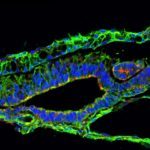Lien vers Pubmed [PMID] – 16100089
Development 2005 Sep;132(17):3895-905
The regulation of cell adhesion in epithelia is a fundamental process governing morphogenesis in embryos and a key step in the progression of invasive cancers. Here, we have analysed the molecular pathways controlling the epithelial organisation of somites. Somites are mesodermal epithelial structures of vertebrate embryos that undergo several changes in cell adhesion during early embryonic life. We show that Wnt6 in the ectoderm overlaying the somites, but not Wnt1 in the neighbouring neural tube, is the most likely candidate molecule responsible for the maintenance of the epithelial structure of the dorsal compartment of the somite: the dermomyotome. We characterised the signalling pathway that mediates Wnt6 activity. Our experiments suggest that the Wnt receptor molecule Frizzled7 probably transduces the Wnt6 signal. Intracellularly, this leads to the activation of the beta-catenin/LEF1-dependent pathway. Finally, we demonstrate that the bHLH transcription factor paraxis, which was previously shown to be a major player in the epithelial organisation of somites, is a target of the beta-catenin signal. We conclude that beta-catenin activity, initiated by Wnt6 and mediated by paraxis, is required for the maintenance of the epithelial structure of somites.
